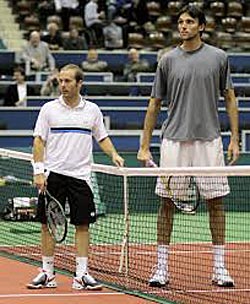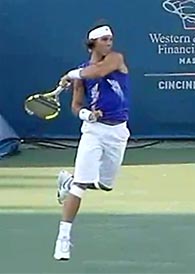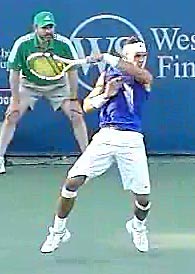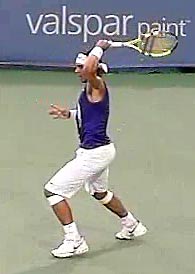|
TennisOne Lessons A Passing Shot … Philippe Azar ….Is a passing shot, is a passing shot, no matter where you hit it. Tennis is such an incredibly simple sport: the ball has to go over a net and can land anywhere in a big space between three lines (think how big a ping pong table is in comparison!) — and you just have to do that one more time than your opponent. Seems simple, right? Yet some players have made an art of complicating this sport. The following are some of the top misconceptions that I’ve encountered. I’m Too Slow Have you ever noticed how older and very experienced players seem to always be in the right place at the right time? Very rarely do they seem rushed and they get to just about every ball? Well, it certainly isn’t their running speed that's keeping them in points. In fact, very rarely is speed a factor in a player’s ability to cover the court and effectively reach difficult balls. Two other factors are far more important:
Yes, there's little doubt that having good footwork, great balance and quick reactions all help you get to more balls but the foundations of efficient movement around the court are born out of tactical awareness and experience of the general trends and individual preferences of your opponent. My backhand Has to be as Powerful and Precise as My Forehand
There has never been and probably never will be a player in the world whose forehand and backhand match up equally. Every player has a preference (even if only slight) for one or the other — one of them is either more powerful, precise, consistent or holds up better under pressure situations than the other. You observe this amongst top players all time. Everyone of them has a signature shot even the all-time greats of the game. Who can argue with the dominance Steffi Graf’s forehand for example. So, rest assured, if none of the best players were equal off both wings, you’re in good company. So, rather than striving to make both strokes equally good, the aim should be instead to develop a weapon out of one of your wings with which you can pressure your opponent when an opportunity arises and make the other wing just indestructibly consistent. You want to become the kind of player whom opponents say “Gee, if I play it to his forehand, he hurts me; and if I play it to his backhand, he never misses” — that’s very demoralizing for an opponent to realize. Balls Have to be Hit 0.7267" Over the Net, Just Like the Pros It might look it that way when watching tennis on TV but the reality is very different. Statistics kept during the 2013 Australian Open showed that Rafael Nadal hit his forehand on average 90” above the net, Federer 70”, Djokovic 63”, and Murray 59”.
The problems with aiming the ball very close to the net are many-fold. For one, you never actually want to lose the point because the ball didn’t make it over the net when your opponent is at the baseline. It’s the worst possible mistake in tennis because you didn’t even give yourself a chance of getting the ball into the opponent’s court. Secondly, low balls generally bounce lower, which is an easier hit for an opponent, whereas a ball hit with more arc will bounce higher and has a better chance of forcing an opponent to either hit the ball at higher contact point (more difficult) or force them to move back. Case in point is Nadal’s nightmarish topspin loop that often disarms Federer’s backhand. And thirdly, lower balls tend to land shorter in the court which, combined with a lower bounce makes for an inviting offensive opportunity for an opponent. If you’re in the business of looking cool-on-court, keep hitting those balls low, but if you’re more interested in winning, hit with arc. I’m Not Tall Enough to Serve Hard
Yes, Karlovic just seems to hit the hardest, meanest, aciest serves at will and is toweringly tall. But, truth be known, power on the serve is not a product of height. A 5 foot tall player is capable of hitting just as hard as or even harder than a 6 foot player because power ultimately is generated by racket acceleration not height. And racket acceleration depends on the looseness of the wrist which is the direct link between our bodies and the racket. According to research carried out by Howard Brody in his book “Tennis Science for Tennis Players,” the only advantage of being tall with regards to serving is that, all other things being equal (such as racket acceleration), the laws of physics give you a higher probability of hitting your serves in the box. “As an example, if you hit your serve at 90 miles/hour, increasing the ball height from 85 to 105 inches will double your chances of getting the serve in” So, there is no denying that taller players have a natural advantage in the percentage of hard serves going in compared to smaller players but it’s not true that being taller equals more power. Don’t Forget the Follow-Through Who hasn’t heard this piece of instruction countless times? So much advice (especially on groundstrokes) revolves around where and how the follow-through should flow and finish, and that it can somehow magically affect the quality of the shot. And yet that makes no logical sense whatsoever. Once contact has been made with the ball and it’s left the strings heading to the opponent’s court, that ball is gone — no amount or style of follow-through is going to make the slightest difference. In fact, theoretically, every swing could stop immediately after contact with the ball. But the follow-through does have one very important role — it prevents injuries by slowing the arm and racket acceleration naturally, minimizing any strain on the arm and shoulder.
So, the next time your ball goes sailing, look for something else to blame than your follow-through, such as controlling your racket angle at the point of contact. Aim Your Passing Shots Close to the Baseline When your opponent is at the net, the heat is on. They are in a position of offence and you are on defense. You definitely do not want to engage into a rally with a net player because they are able to finish the point off very easily. So, the idea is to turn the tables and put the net player on the defensive. Amongst other options such as the lob or low ball, there is the passing shot. And for some reason, a lot of people believe that this shot should land as close to the baseline as possible. There are, however, a few problems with this approach. A passing shot is a passing shot no matter where it lands. As long as the net player can’t touch it, it can land 3 inches beyond the net or 3 inches from the baseline, so…. If you aim close to the baseline, you run the risk of having the ball not just land out-wide but also wide-long. Whereas if you aim for your passing shot to land anywhere shorter than the baseline, the only error that can happen is wide-out, thereby reducing your margin of error by 50% — that’s pretty substantial. Also, aiming deep usually means hitting the ball with somewhat more arc. But, if it’s anything less than a perfect passing shot, the net player will be able to reach it and hit down and away on it. Instead, by keeping the ball low over the net, even if the opponent does reach it, it will be a tough volley for the net player. The couple of options that will keep the ball low and the passing shot landing short is to either use backspin (which, by nature, travels low over the net) or a low and heavy topspin stroke that dips suddenly and violently soon after crossing the net on the opponent’s side.
But, whichever one works best for you, cut your margin of error by aiming your passing shots shorter. Volleys Should Land Deep The final classic misconception is that volleys should be aimed deep. First off, we need to be clear that a skilful net player knows how to aim any volley in any direction or depth. But the most effective volley is generally the short volley. Why? Well, if you’re at the net and your opponent is standing at the baseline, it makes little strategic sense to hit back deep towards the baseline. The best way to make life for the baseliner difficult from the net is to make them run the longest distance to reach the ball; which usually means dropping the volley as short as possible and ideally with some sideways direction to add spice. Think short and away when at the net. There are more examples similar to the ones that have been described here and so many misconceptions, misinterpretations and misunderstandings, it's little wonder players make so many mistakes. But, this need not be: observe the best players, question your status quo and your deepest beliefs, experiment with the advice given here and you will see that common-sense tennis always prevails. Your comments are welcome. Let us know what you think about Philippe Azar 's article by emailing us here at TennisOne.
Philippe Azar is a 20 year teaching professional and lifetime student of the game who currently works as a Regional Manager for Peter Burwash International (PBI). PBI contracts with resorts, hotels and clubs all over the world to direct tennis programs.The company presently has professionals working at 62 facilities in North America, Europe, Asia, Middle East, Caribbean, Pacific and Indian Ocean. During its 35 years in business, PBI tennis professionals have taught tennis in over 135 countries.For more information www.pbitennis.com.. |



